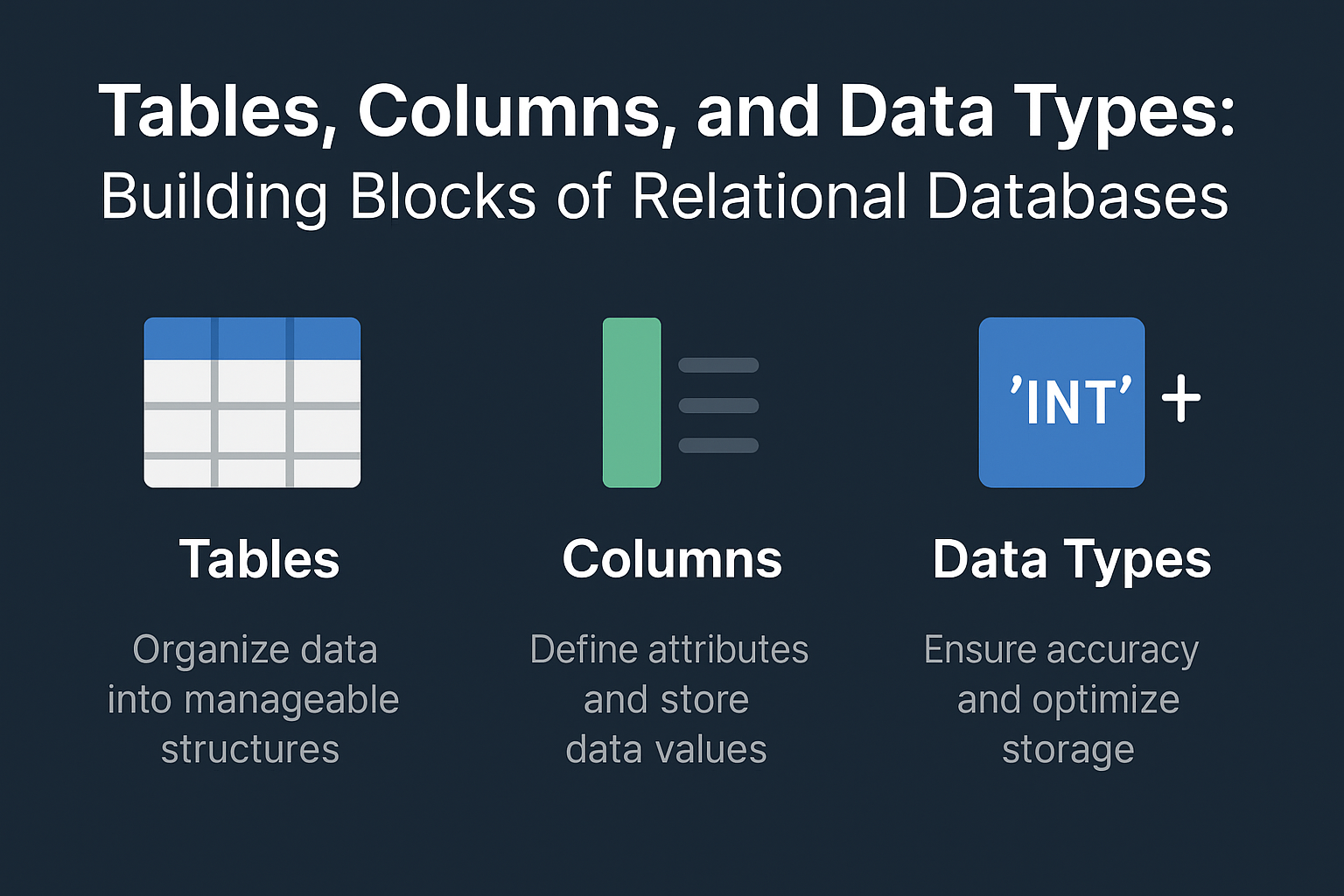Introduction
Tables, columns, and data types are the core building blocks of relational databases. Every piece of data is stored in a table, organized into columns with specific data types. Properly designing these structures is critical for performance, scalability, and data integrity.
Why They Matter
- Tables organize data into manageable structures.
- Columns define attributes and store specific data values.
- Data Types ensure accuracy and optimize storage.
Real-world analogy:
Think of a table as a filing cabinet. Each drawer (table) holds folders (rows), and inside each folder are documents (columns) with specific formats (data types).
Core Concepts
1. Tables
A table is a collection of rows and columns representing a specific entity.
Example: Customers Table
| customer_id | name | |
|---|---|---|
| 1 | John Smith | john@example.com |
| 2 | Jane Doe | jane@example.com |
2. Columns
Columns define the attributes of an entity. Each column has a name and a data type.
3. Data Types
Data types determine what kind of values a column can store.
Common Data Types:
| Type | Description | Example Values |
|---|---|---|
| INT | Whole numbers | 1, 42, 1000 |
| VARCHAR(n) | Variable-length strings | 'John', 'Jane Doe' |
| DATE | Calendar dates | '2025-07-31' |
| BOOLEAN | True or False values | TRUE, FALSE |
| DECIMAL(p,s) | Fixed-point numbers | 123.45, 9999.99 |
| TEXT | Large blocks of text | 'Customer comments' |
SQL Examples
Creating a Table
CREATE TABLE customers (
customer_id SERIAL PRIMARY KEY,
name VARCHAR(50) NOT NULL,
email VARCHAR(100) UNIQUE,
signup_date DATE DEFAULT CURRENT_DATE
);
Inserting Data
INSERT INTO customers (name, email)
VALUES ('John Smith', 'john@example.com');
Querying Data
SELECT name, email FROM customers WHERE signup_date > '2025-01-01';
Real-World Use Cases
- E-commerce: Products, orders, and customers stored in tables.
- Banking: Accounts, transactions, and balances.
- Healthcare: Patients, appointments, and medical records.
Common Mistakes and Anti-Patterns
- Using incorrect data types: Storing numbers as strings impacts performance.
- Not defining constraints: Leads to inconsistent data.
- Overusing large types: Using TEXT instead of VARCHAR increases storage.
Performance and Scalability Implications
- Proper data types reduce storage and improve query speed.
- Indexing columns enhances performance but increases write overhead.
- Choosing efficient types like INT over BIGINT when appropriate saves space.
RDBMS Comparison
| Feature | PostgreSQL | MySQL | Oracle |
|---|---|---|---|
| Default String | TEXT/VARCHAR | VARCHAR | VARCHAR2 |
| Auto Increment | SERIAL | AUTO_INCREMENT | SEQUENCE |
| JSON Support | Excellent | Basic | Good |
Best Practices & Optimization Tips
- Use the smallest appropriate data type.
- Define primary keys for every table.
- Normalize to avoid redundancy, but balance with performance.
- Document table schemas for maintainability.
When to Use vs When to Avoid
Use Proper Tables/Columns/Data Types When:
- You need structured, consistent data.
- Relationships and constraints are critical.
Avoid Over-Engineering When:
- Data is simple and temporary (use flat files or in-memory storage).
Conclusion & Key Takeaways
Tables, columns, and data types are the backbone of relational databases. Designing them thoughtfully ensures efficiency, integrity, and scalability.
Key Points:
- Use appropriate data types for accuracy and performance.
- Tables represent entities; columns define their attributes.
- Constraints and normalization maintain data integrity.
FAQ
1. What is a table in a database?
A structured collection of rows and columns representing an entity.
2. What are columns in a table?
Attributes of an entity, each with a specific data type.
3. What are data types?
Definitions of the type of data a column can hold.
4. What is the difference between VARCHAR and TEXT?
VARCHAR has a defined limit; TEXT is for large, unbounded strings.
5. How do I choose the right data type?
Match the type to the data’s nature and size.
6. What is a primary key?
A unique identifier for each row in a table.
7. Can I change a column’s data type later?
Yes, but it may require data migration and downtime.
8. What is a default value in a column?
A predefined value inserted when no value is provided.
9. What happens if I use the wrong data type?
It can cause performance issues and data integrity problems.
10. Are data types the same across all RDBMS?
No, some types differ (e.g., Oracle uses VARCHAR2, PostgreSQL uses SERIAL).
